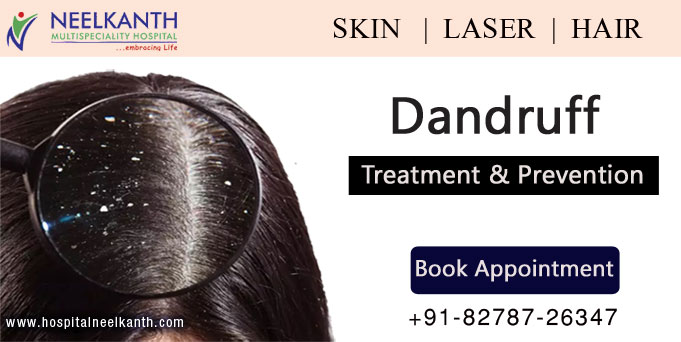Dandruff, a common chronic scalp condition, is incredibly annoying and unsightly. Unfortunately, the problem can represent more than just pesky white flakes falling from your scalp like a mini blizzard.Once in a lifetime, everyone has an embarrassing urge to scratch their head in public. Or you are scared of wearing dark coloured clothes just because of visible falling flakes on your shoulder or back. Although it is a harmless condition but, it can be infuriating and embarrassing. Consult the Best Hair Surgeon in Himachal to get rid from these hair problem.
Here are some key points about dandruff.
- Dandruff is a common condition, but it can be embarrassing and difficult to treat.
- It is not related to hygiene, but washing and brushing the hair can help remove old skin flakes.
- Risk factors include having certain skin or medical conditions and the use of inappropriate hair products.
- Various treatments are available over the counter, but more severe cases should be seen by a Best Dermatologist in Manali.
Causes of having Dandruff :-
Dandruff can be caused by a number of things, including dry skin; sensitivity to hair products; and skin conditions such as seborrheic dermatitis or eczema.The overgrowth of a yeast-like fungus can also cause dandruff. This overgrowth can be caused by stress, hormones, too much oil on the scalp, or problems with the immune system.
The first step to getting rid of dandruff is understanding where it comes from. The cause of dandruff has been linked to a build-up of Malassezia on the scalp. Malassezia is a yeast-like fungus that grows in oily areas of the scalp. When the scalp’s natural defences becomes compromised, irritants produced by malassezia penetrate the scalp barrier and cause it to produce and shed more skin cells than usual. The greyish yellow flakes we associate with dandruff are these skin cells falling from the scalp.
- Seborrheic dermatitis –Dandruff involves flakes of skin that collect in the hair.People with seborrheic dermatitis have irritated, oily skin, and they are more likely to have dandruff.
- Not enough hair brushing – Combing or brushing the hair regularly reduces the risk of dandruff, because it aids in the normal shedding of skin.
- Dry skin – People with dry skin are more likely to have dandruff. Cold winter air combined with overheated rooms is a common cause of itchy, flaking skin. Dandruff that stems from dry skin tends to have smaller, non-oily flakes.
- Certain skin conditions – People with psoriasis, eczema, and some other skin disorders tend to get dandruff more frequently than others. Tinea capitis, a fungal infection also known as scalp ringworm, can cause dandruff.
For the complete examination of the head scalp consult the Hair Surgeon in Kullu, Manali.
Symptoms and Complications:-
The symptoms of dandruff include white flakes of dead skin in the hair and on the shoulders, as well as an itchy, red, or scaly scalp.Dandruff flakes are usually scattered throughout the scalp.
If seborrheic dermatitis is the cause of dandruff, the symptoms usually appear gradually. The scalp becomes dry or greasy, is red, and feels itchy. As skin cells die, they turn to yellowish scales. A bad case of seborrheic dermatitis can also cause symptoms in other parts of the body. Yellowish or reddish scaling can appear on the hairline, in and around the ears, or on the nose and chest.
Making the Diagnosis:-
Dandruff is a condition that people can pretty much self-diagnose from the symptoms of an itchy, dry, and scaly scalp. Seborrheic dermatitis appears as reddish-looking skin with mild, greasy, yellow scales and plaques with indistinct margins. Visit our Hair Transplant Center in Akahara Bazar Kullu to diagnose the hair problems.
Treatment and Prevention
Dandruff can often be a chronic condition, but it can be controlled with the proper treatment. First, try shampooing with a non-medicated shampoo, massaging the scalp firmly, and then rinsing well. Frequent shampooing removes flakes, reduces oiliness, and prevents dead skin cell buildup. If this fails to help, special anti dandruff shampoos are usually helpful. Instructions for use depend on the specific shampoo used. Some are used on a daily basis, while other are used only once or twice weekly.
- A dry and dehydrated scalp can make your dandruff symptoms much worse than they already are and lead to itchiness and further flaking. Keep your scalp hydrated and itch free by drinking plenty of water so that your body can replenish any lost moisture.
- The scalp produces a natural oil called sebum that provides a natural layer of protection essential to keeping it hydrated and staving off dryness. However, too much sebum on the scalp can make your hair greasy and contribute to outbreaks of dandruff.
- The most important step to getting rid of dandruff, and making sure it doesn’t come back, is using an anti-dandruff shampoo. Anti-dandruff shampoos are readily available at most pharmacies and shops and are great because they not only treat the symptoms of dandruff but keep them from coming back with regular use.
- To help keep dandruff under control, shampoo frequently, reduce your stress levels, try reducing or stopping your use of hair products (e.g., gels and sprays), and eat a healthy diet.
Make an Appointment @ +91-8278726347

